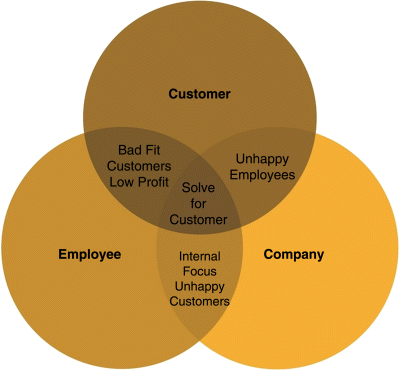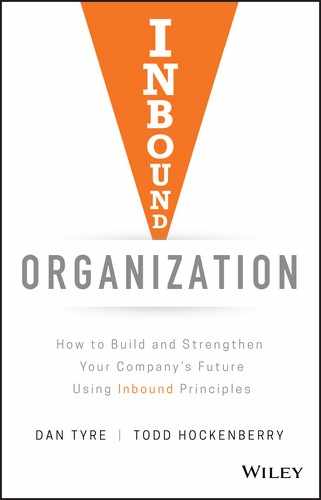Chapter 7
Inbound Decision Making
Inbound organizations solve problems with an emphasis on enterprise value (EV), which means acting in the best interest of the company as a whole and accepting decisions that help the company mission, even if it makes your job harder. EV means solving for the long-term success of the organization so it delivers value to customers.
What does solving for EV mean in real terms? Let's say you are a direct sales rep working on a target account and you are forecasting a deal close date by the end of the quarter. In the final weeks before signing the contract, the prospect decides that they would like to have a partner do some of the services associated with the installation. As the partner gets involved in the deal, they realize that it is in the prospect's best interest to delay the sale. Solving for EV means that the direct rep works with the partner in the best interest of the customer, which is in the best interest of the company. Even if it takes the salesperson longer to close the deal and she makes less commission, she does it because that decision solves for EV.
Another example would be a product manager that is looking to add functionality to the next generation of an existing product. The new functionality will attract a lot of new customers, who have been delaying their purchase until this new feature is available. But the new feature is immature. If the company deploys the functionality in the next product release, the support organization will receive hundreds of additional calls regarding how to install it, use it, and get the right results. Although the functionality is valuable in its current state, the product manager realizes that deploying it in the next version will place a heavy, expensive burden on the support team that would impact overall customer satisfaction. So solving for EV means delaying the release until the next version because it is in the best interest of the customer and of the company even if it impacts sales in the short term.
Solving for EV requires a balance. Many employees would love to spend more money helping customers with no regard for the health of the organization. Solving for the customer at the expense of the organization may feel good at the time, but those decisions may create terrible margins and decrease EV in the long run (see Figure 7.1).

Figure 7.1 Solving for Enterprise Value by Solving for the Customer.
Inbound Decisions
There are three components to every decision: (1) outlining the actual options that you can choose, (2) who is best suited to make the decision, and (3) the timing of the decision. The team members who are closest to the problem should be in the best position to address these three components.
Dharmesh Shah comments on the third component of decision making, when to make the decision:
The “optionality tax” is one of the biggest lessons we've learned at HubSpot. In the early stages, we often need to keep our options open, because there's no telling what we're going to run into and the chances are high that we'll head down some dead-end roads and need to backtrack.
But, this gets more expensive over time. Too many entrepreneurs (including me) make the mistake of thinking something is a “costless option.” Truth be told, there is no such thing. Every option has some cost—it's just that in many cases, they are hidden costs.
And, the optionality tax is not limited to just target market selection, it is everywhere.1
It is better to let an idea go unpursued than to keep the option open, draining resources without an actual chance of success.2
An important part of decision making is deciding not to do something. Identifying what not to do is a central part of creating effective MSPOTs. Omissions are critical to inbound teams because they provide the focus for teams to stay aligned.
Some teams avoid omissions in an attempt to make everyone happy. The result is an uninspired compromise. Uninspired compromise happens when teams take the path of least resistance and refuse to make a real decision. The deciding factor becomes what makes the least number of people unhappy. Decisions should focus on EV and helping customers.
J. D. Sherman describes the outcome of good inbound decisions:
There are winners and losers, and people have to be good with that. Managers must help internal groups collaborate and not dictate a specific set of tasks or pathways but let employees own the strategies and plays. If leaders and managers are making all of the decisions, then we know we are not true to our culture, to being inbound, and we work hard to understand why people do not feel empowered to decide and fix it.3
Brian Halligan describes good inbound team decision making this way: “The sign of a good team is that they can have a healthy debate, but once a decision gets made whether they won the debate or not, they need to line up behind it. If you don't have that feature of your team, it is hard to scale.”4
Sherman discusses inbound decisions:
What I spend a lot of time on is making sure that we're living up to this inbound philosophy of empowering the organization and our employees. Much like we do by educating our customers with the inbound philosophy, we want to treat our people the same way. An example would be when an employee screws up there's such an incentive, a natural reaction even, to make rules so that this particular mistake doesn't happen again.
We want to gather all the facts, we want to consider all of the alternatives, we want to make a decision, and then we want to move on. At first, this can be hard. People put a lot of time and effort into evaluating and supporting their recommendations, but an inbound culture has a commitment to making difficult decisions, and when the decision is complete the entire company will stand behind that decision.5
Not all decisions have the same impact on the organization.
Some decisions are more important than others. Lorrie Norrington, lead director for the HubSpot Board of Directors, defines a decision framework for which kind of decisions leaders should focus on. There are four boxes that define all the company decisions (see Figure 7.2). The two axes define importance and permanence of the decision.

Figure 7.2 Norrington Decision-Making Matrix.
All decisions are categorized into one of the boxes in this diagram.
If the decision falls into the two lefthand boxes or lower righthand box, then you should move forward because there is always a way to reverse course if you make the wrong decision.
At the other end of the spectrum, in the upper righthand box, if the decision is a big bet that impacts lots of people, or will be messy to reverse because it has important customer impact or requires changes in systems or processes, you need to vet it out completely with leadership. Work with senior leaders to make sure that you have all of the information, have clarified who owns the decision rights, have thought through all the potential scenarios, and have taken extra time to get it right.
Only the decisions that fall into the bet-your-company boxes, requiring huge resource shifts, require senior executive-level discussions. Push everything else to the teams. Bet-your-company decisions include making an acquisition that could stretch your balance sheet, an investment in an international office, expensive R&D for a new product line, or launching a freemium product needing considerable support.
Use Good Judgment
An inbound workforce doesn't need a policy manual to tell them what to do. A printed policy manual becomes outdated immediately. It is impossible to anticipate every problem or ethical dilemma that your employees will face as they run the business. It is also hard to give reliable guidance on every option for every imaginable problem. Even if you could anticipate every situation, most people wouldn't have the time or inclination to read about it anyway. Employees don't want or need a lot of rules and regulations that define how to behave in every conceivable situation. The very concept of a policy manual is condescending because it signals to your employees that you do not trust them to think through and solve problems themselves.
HubSpot has only one rule that governs all employee behavior—use good judgment. Should a salesperson take a client out for an expensive dinner? Should a software engineer handle a personal issue and come in late? Should an accounts payable clerk take work time to help a colleague in another department during the busy season? Should a product manager post their personal views on social media? The answer to each of those questions? Use good judgment.
Brad Coffey, HubSpot vice president of strategy, puts it this way:
We trust our people to make good judgments, and when they don't we ask ourselves as leaders what did we do wrong, what did we fail to communicate that led to this decision? If you manage this way, you fundamentally get a much more empowered workforce that solves more for the customer than if they were burdened with a heavy set of rules and policies. That is how you end up driving alignment in a culture where people have a lot of autonomy.6
What happens when employees don't use good judgment? As human beings, this happens. Bad judgment becomes a teaching moment. An organization that takes the approach of reviewing the available information and evaluating the moral, ethical, legal, operational, and business implications, and then lets the line manager decide, sends a message of trust and accountability to everyone in organization.
After defining inbound decision making the next step is to create an inbound operating system.
